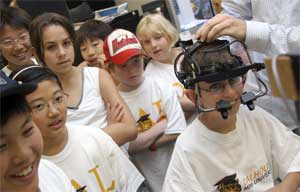 |
| Participants and chaperones with the First Nation and Inuit National Science camp pose for a group photo in front of the Henry Hicks building. (Abriel photo) |
It wasnÕt dissecting a sheepÕs eye or smashing an apple frozen with liquid nitrogen that got Sarahann Shaimaiyuk all excited so much as her first glimpse of a red squirrel.
ÒI got scared,” confesses the 13-year-old Inuit girl with a shiver, talking about her run-in with one of the bold, agile rodents. ÒI canÕt wait to tell my mom about it.”
The Grade 8 student from Aqsanit Middle School in Iqalait was one of 44 aboriginal teenagers and 22 chaperones from across the country who converged at Dalhousie University for the fifth annual First Nation and Inuit National Science Camp. Over a three-day, jam-packed schedule, they got to make casts of fossils, create blue slime, handle sea creatures, visit labs, talk to researchers and learn about careers in science, the health professions and medicine.
Most of the students arrived in Halifax on Sunday. While at Dalhousie, theyÕre focusing on educational experiences related to science and technology. Later in the week, theyÕll travel to the University of New Brunswick, where theyÕll learn about Aboriginal history, forestry and hydroelectricity, and to Kingsclear First Nation, where theyÕll enjoy a traditional Maliseet feast of moose, salmon and lobster.
ÒItÕs the first time IÕve been south. ItÕs the first time IÕve been away from my mom,” says the Nunavut native, proudly wearing a bright yellow T-shirt she won earlier in the day. ÒI miss her, but IÕve got a lot of friends now.”
Social interaction is an important part of the camp experience, says Manson Gloade, with Indian and Northern Affairs - Atlantic.
ÒThey arrive not knowing each other, but they leave having developed friendships to last a lifetime,” he says, as the students assembled for a group photograph in front of the Henry Hicks Arts & Administration Building.
 |
| Wearing their Dal T-shirts, kids take part in a mini-university camp. |
Dalhousie campus plays host to all kinds of young learners throughout the summer. More than 140 kids took part in mini-university camps over the past four weeks. The camps provide students, ages 10 to 16, with a taste of university life through activities led by senior Dal students specializing in theatre, international development studies, marine biology and kinesiology.
ÒThese arenÕt programs where the kids have assignments and do homework,” says Angela Barrett, campus recreation coordinator. ÒTheyÕre just a lot of fun.”
But the mini-university camps are only a part of what Dalhousie Athletics and Recreational Services offers. In all, more than 1,800 kids will take part in leadership, sport and recreational camps over the summer. Coming up in the next few weeks are camps including aquatic adventures, water polo, rock climbing, Shakespeare by the Sea theatre camp, and superskills soccer.
Speaking of super, SuperNOVA offers science, computer science and engineering camps for kids in Grades 1 to 8 at Dalhousie throughout the summer. ItÕs the twelfth year for the popular week-long camps, which are taught by Dalhousie undergraduate students and recent graduates. Leaders are assisted by high school students, who take the CATALYST leadership and science skills program at the beginning of July and stay involved by volunteering.
 |
| A SuperNOVA camper learns about a fish's digestive system by doing a dissection. (SuperNOVA photo) |
ÒSuperNOVA teaches scientific concepts to kids in a fun, hands-on way,” explains Jill Rourke, co-director of SuperNOVA.
For example, the campers are learning about acidity and alkalinity by taking soil and water samples and adding various chemicals to them. TheyÕre also doing experiments using Jell-O and pineapple in various states (dried, frozen and heated) to learn about enzymes. Along the way, theyÕll learn scientific methods and how to examine their results Ñ ÒItÕs really a brief intro to doing research,” explains Ms. Rourke, who recently graduated from Dalhousie with a degree in biochemistry.
ÒI think the kids overwhelm their parents with everything they learn,” she adds.
